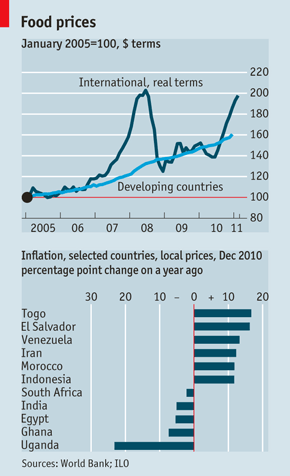Last updated on June 8, 2011
The Economist‘s Daily Chart blog had a post yesterday was about food price inflation. The point of the post was to illustrate how food price inflation over the last year had not affected all countries equally. To wit:
The post explains:
“The local price of food in developing countries has not risen quite as sharply in recent months as global prices have. This is in part due to exchange-rate movements: the depreciation of the dollar against many other currencies has blunted the impact of an increase in the dollar price of food. In addition, some developing countries had good harvests of products that are mainly consumed domestically. This meant that local prices rose far less sharply than international prices, which are driven by crops that are traded across borders.”
Fair enough, but having collected my own data a few times in developing countries, I know first-hand how difficult it is to collect accurate price data.
If there is a measurement error problem — and I am not saying there is one; I am not familiar with the World Bank’s food price index, so I don’t know — then it most likely has multiple sources: Were prices collected in a representative set of geographical locations within a given country? Were prices collected at roughly the same time across countries? Did the basket of commodities used to compute each country’s price index accurately reflect the average basket of commodities consumed in that country?
All these sources of measurement error can add up to large spurious discrepancies between country-specific indices. Again, I don’t know whether that is the case with these indices.
Generally, this does change the fact that food prices have increased dramatically since last year. Some states may have decreased their unemployment rate between April and May, but that does not change the fact that the US unemployment rate has increased from 9.0 to 9.1 percent between April and May.
(HT: Tom over at A View from the Cave.)
